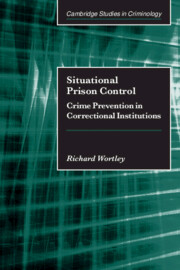Book contents
- Frontmatter
- Contents
- List of figures and tables
- Foreword
- Acknowledgements
- Part I Theoretical foundations
- Part II Specific behaviours
- 5 Prisoner-prisoner violence
- 6 Sexual assaults
- 7 Prisoner-staff violence
- 8 Self-harm
- 9 Drug use
- 10 Escapes
- 11 Collective disorder
- 12 Conclusions: hard and soft situational prison control
- List of references
- Index
12 - Conclusions: hard and soft situational prison control
Published online by Cambridge University Press: 22 September 2009
- Frontmatter
- Contents
- List of figures and tables
- Foreword
- Acknowledgements
- Part I Theoretical foundations
- Part II Specific behaviours
- 5 Prisoner-prisoner violence
- 6 Sexual assaults
- 7 Prisoner-staff violence
- 8 Self-harm
- 9 Drug use
- 10 Escapes
- 11 Collective disorder
- 12 Conclusions: hard and soft situational prison control
- List of references
- Index
Summary
The analysis of situational prison control undertaken in this book has been based on the following assumptions:
A great deal of prison disorder is a function of characteristics of the prison environment
The environmental forces acting upon prisoners can both generate misbehaviour and provide the opportunities that allow misbehaviour to occur
Prison disorder can be prevented by changing the prison environment in ways that reduce the propensity of prisoners to misbehave and make misbehaviour more difficult to perform
Prevention attempts that fail to address adequately the environmental factors that both generate and allow misbehaviour are likely to be ineffective and may even increase disorder.
These assumptions were formulated into a two-stage model of prison control. The model was tested against the available situational research on seven specific kinds of prison misbehaviour – prisoner-prisoner violence, sexual assaults, prisoner-staff violence, self-harm, drug use, escapes and collective disorder. The purpose of this concluding chapter is to assess the contributions that a situational perspective can bring to an understanding of prison disorder and its control and, more specifically, to consider the overall utility of the proposed model in accounting for the data.
Is situational prison control necessary?
The point has been made that prison control necessarily involves situational elements. Both hard and soft prison control have existed long before the articulation of situational crime prevention as a criminological model. The question might be asked, then, how does a situational approach differ from existing conceptions of control?
- Type
- Chapter
- Information
- Situational Prison ControlCrime Prevention in Correctional Institutions, pp. 211 - 225Publisher: Cambridge University PressPrint publication year: 2002



